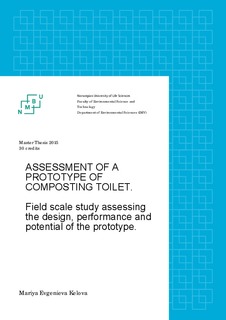| dc.description.abstract | Common problems with composting toilets are the appearance of odors, the control of the
moisture content and the heat and energy demand. The objective of this study is to assess the
performance of an innovative design of a composting toilet that targets to improve the performance
for cold climate especially. Solar energy is utilized to optimize ventilation and provide temperature for
better composting and evaporation control.
The system was conceptualized by Petter Jenssen, Petter Heyerdahl and Jon Fredrik Hanssen and
was built by Jørgen Kjørven in Grua, Lunner municipality, Norway. The installation consist of
solar air collector, gravel bed and composting chamber. The solar collector transforms the solar
radiation to heat. The heat is transported by air that is sucked through the system by an exhaust
fan. The gravel bed function as heat storage. The target of the design is to transport heat to the
composting chamber to facilitate the degradation, evaporation and sanitization of the compost.
The system was optimized along with this study and modifications are described and assessed.
The assessment is based on measurement of air temperature, light intensity, air flow, evaporation
visual observations, and an interview with the users. The results are analyzed in terms of air and
heat flow within the system, incoming solar radiation and heat storage capacity. Furthermore, the
potential of the toilet system design is discussed and improvements suggested.
The performance of the system was correlated to airflow velocity and improved when air
leakages and heat losses were reduced. The mean temperatures in the composting chamber
during the period with the most optimal performance of the system were 10°C higher than the
mean ambient temperatures. The temperatures in the solar collector reached up to 80°C.
Comparison of the airflow at the inlet and outlet of the system showed that the air path was not
sealed properly and when the leakages were sealed the airflow velocity was increased. The heat
flow estimations in the system identified that only 20-25% of the solar energy was utilized and
that during daytime the energy is transferred from the solar collector to the composting chamber.
The energy flow in the system is as follows: energy is gained by the air in the solar collector, in
the gravel bed this energy is transferred to the rocks, some of the residual energy is used to warm
the compost chamber and some is lost with the exhaust air.
3
The results suggest that the present design will have beneficial effect on the composting process
but the future development of the prototype theoretically have the potential to sanitize the
compost in the warm months and to prolong the time without freezing in the cold months. | nb_NO |
